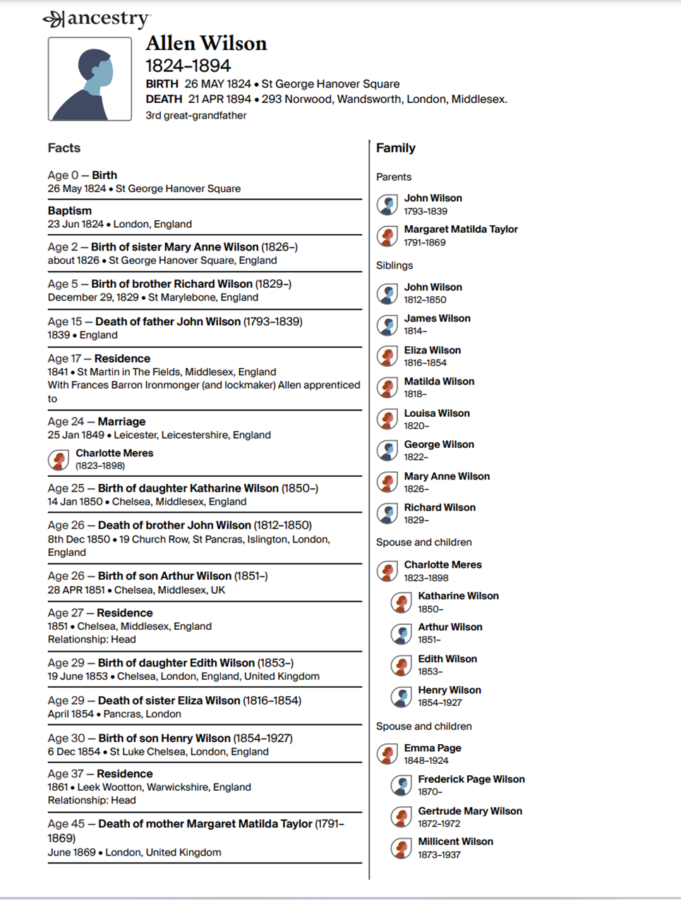The Tiny Lock

The late afternoon sunlight streaming through the window lit the glass cabinet overflowing with an array of precious, intricate, and colourful family curios and memories. Carefully curated by my mother, with no obvious chronology, generations of memorabilia have been nurtured, dusted, polished, and displayed on the two painted wooden shelves of the homemade glass-fronted cabinet.
Gingerly I slide open the glass door, careful not to leave fingerprints on the gleaming glass as it splutters and scrapes along reluctant runners. Peering inside, at the now exposed contents, I almost missed the tiny, tarnished lock amongst the more flamboyant and ornate relics: the cymbal-crashing monkey wearing a faded suit, the fragile cream-coloured Beleek Irish porcelain, my grandmother’s gold and white afternoon tea set – the china that was always saved “for best”. Curiosity led to closer inspection of the lock and so another ancestral story began.

The miniature brass lock was no bigger than a matchbox with a twisted piece of coarse string looped through the key, that was inserted in the lock’s keyhole. A tiny working lock. Around the keyhole, engraved words grandly proclaim “Lock Makers to Her Majesty. Office of Works.” With the names Barron Son and Wilson, of 436 The Strand. The front is a flat surface interrupted by a small keyhole with two holes at each end to secure the lock.

Quick and inexact research finds an entry in the Index of Locksmiths expanding the information from the names engraved on the lock. Adding: “Barron – Barron & Son, Barron, Son & Wilson, Barron & Wilson (Robert Barron, Francis William Evans Barron, Francis John Barron and Allen Wilson): 66 Barbican, London – 436 (West) Strand, London.” [1] ‘Allen Wilson’, being my 3X great-grandfather.

Beside the lock sits a blurred copy of a hand-scribed document, its edges curled with age and exposure. The document appears to be a contract written when Allen Wilson was accepted as an apprentice to Frances Barron. Dated 1839, the copy yields valuable insights as it states:
“I Allen Wilson son of Matilda Wilson widow of John Wilson formerly of Bond Street in the county of Middlesex Tailor deceased with the consent of his said mother bound apprentice to Frances Barron of West Strand Ironmonger do promise to be obedient to the Master ?? of the worshipped company of Ironmongers London during my life and to my ?? ?? Master during my apprenticeship ?? my hand this eleventh day of May 1839” Signed by ?? and Allen Wilson”.
Frustratingly the source of this brief yet illuminating document is not known. In addition, some words are difficult to decipher (marked ?? above).
Family records show Allen Wilson, born in 1825, was the seventh of John and Matilda Wilson’s nine children. Using finger-counting arithmetic, I calculate he was just 14 years old at the time he began this apprenticeship, and only one month after his father died. It was difficult to contemplate the feelings of mother and son as I considered the “what if” this was to happen today.
A short time after discovering the lock, a chance meeting with a locksmith at a fair celebrating “Lost Trades” seemed a fortuitous opportunity. I hesitantly showed the locksmith, with the carefully coiffed beard, black T-shirt and passionate enthusiasm for locks, the photograph of the tiny lock. I watched as his eyes grew wide with recognition; his excitement palpable as he declared it from the well-known Barron lock makers of 436 Strand.

In the late 18th and early 19th century, the area around 436 Strand was popular with the makers of musical instruments. Before becoming Barron locksmith’s establishment 436 Strand had been a shop making and selling musical instruments, it is suggested the shop has a link to violin-maker Antonio Stradivari and his famous Stradivarius violin.[3] Today many generations on from its days of ancient trades, it is a mobile phone shop. [4]
The Barron family had long been ironmongers and locksmiths, a 1768 directory lists ‘Frances and Robert Barron Braziers and Ironmongers, Strand’[5]. In 1778 their fame spread following the invention of the double barrel lock by Robert Barron [6]. Enabling additional security this lock would be used throughout Windsor Palace [7]pg 28., and by 1817 Frances Barron and Son are advertising as Ironmongers to His Majesty. [6]
It would seem not only did Allen Wilson complete his apprenticeship, but he continued to work with the Barron family eventually becoming a partner. How the tiny lock crossed the world to be displayed in a curio cabinet in New Zealand is a lost tale. Records show Allen remained in London and continued to work as an Ironmonger. After two marriages and ten children, he died in 1894.
If there are any corrections, questions or further information please contact the author Melanie findingappoo@gmail.com – I would be delighted to discover any further information.
NOTE: A record of information regarding Allen Wilson and his family is attached below.
REFERENCES
[1] D. Lucian and C. D. Lucian, ‘Index of Locksmiths’, Antique Box Guide, Sep. 30, 2013. http://www.antiquebox.org/index-of-locksmiths/ (accessed May 12, 2023).
[2] ‘Map Of London 1868, By Edward Weller, F.R.G.S.’ https://london1868.com/weller41.htm (accessed Jun. 14, 2023).
[3] timelost, ‘Strand’, On Books, Streets & Migrant Footprints, Jul. 25, 2015. https://abeautifulbook.wordpress.com/tag/strand/ (accessed Jun. 12, 2023).
[4] ‘Google Maps 436 Strand’, Google Maps. https://www.google.com/maps/place/436+Strand,+London+WC2R+0QN,+UK/@51.5092443,-0.1272603,17z/data=!3m1!4b1!4m6!3m5!1s0x487604cea20615f5:0x63f2994d31688cf1!8m2!3d51.509241!4d-0.1246854!16s%2Fg%2F11c5dq79j2?entry=ttu (accessed Jun. 13, 2023).
[5] ‘Francis Barron | British Museum’. https://www.britishmuseum.org/collection/term/BIOG215623 (accessed Jun. 13, 2023).
[6] ‘The Lock Collectors Association’. http://www.lockcollectors.eu/members/lockdatabase/bar1/_index.htm (accessed May 12, 2023).
[7] M. Friend, The Encyclopaedia for Locksmiths. Authors On Line Ltd, 2004.

